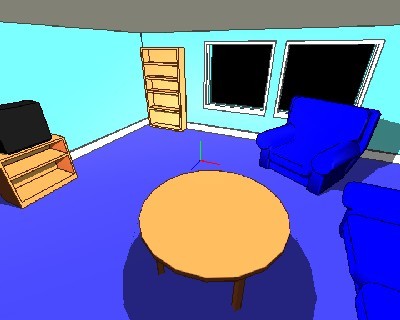main menu
browse the gallery of student projects (select TAG or YEAR) or the archive of animations
browse the gallery of student projects (select TAG or YEAR) or the archive of animations
A dramatic increase in the processing power and graphics capabilities of modern games systems has led to a demand for an increase in realism in their visuals. For the most part, game developers have responded by simply throwing more polygons and textures into the scene. Even most of the clever lighting and atmosphere trickery such as smoke, fires, and light halos are either textured polygons or images composited into the scene. Textures have not gone beyond being applied for colour only, few games have even attempted to include such things as bump-mapping into their graphics engines. The Gouraud shading model is still the dominant method of shading, which, although for the most part adequate for diffuse shading, specular highlights still leave alot to be desired.
This innovations project is to determine the feasibility of incorporating more realistic lighting and shading models into real-time graphics engines through lighting texture maps. Pre-rendered lighting is currently being used in real-time engines for more realistic scenery and environments. They can incorporate some very realistic lighting models such as radiosity and soft-shadows, however, these lighting maps are generated before run-time and as such are static and cannot adapt to changes in lighting. The approach attempted here uses less advanced shading models than radiosity but are intended to be dynamic and could also possibly include real-time bump-mapping as a natural benefit to the method (ie, at no extra processor time). Shadows are also essential for realism, and as such, alot of research has gone into realistic real-time shadows. The success of the work done is questionable. Under certain conditions the results produced look considerably better than those produced by OpenGL’s lighting system alone, but the system starts to collapse with complex geometry.
Researching realistic lighting also lead me to look at the opposite end of the spectrum, at non-photorealistic rendering techniques, most commonly known (and referred to here) as ‘Toon Shading’ or ‘Toon Rendering’. My work in this area was considerably more successful and rewarding so I include it here. The first section of this report focuses on the approach attempted to create realistic rendered graphics using lighting applied to texture maps, it later moves on to another aspect of lighting that is required for realism (and which most real-time rendering systems lack), dynamic shadows. After this, a method of Toon rendering is explained, both for creating outlines and shading.
files
files
The NCCA is delighted to announce the launch of a brand new course for the 2018/19 academic year. ...
Posted By: Chris Williams Date: 17/08/17 Read More...
The annual Tech Nation survey quantifies the value and growth of the UK digital economy, in particular identifying sectors...
Posted By: Richard Southern Date: 22/03/17 Read More...
Hot on the heels of their win at AniFest 2016, Naughty Princess has won the best student animation award...
Posted By: Richard Southern Date: 06/03/17 Read More...
